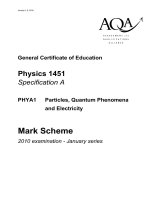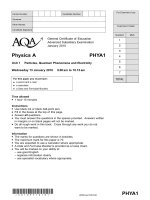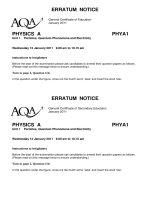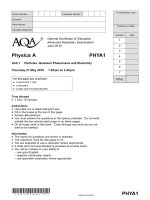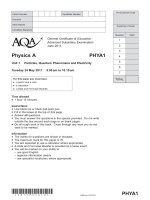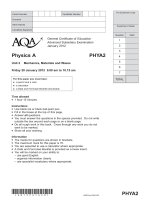- Trang chủ >>
- Khoa Học Tự Nhiên >>
- Vật lý
Vật lý A level:AQA PHYA2 w QP JAN10
Bạn đang xem bản rút gọn của tài liệu. Xem và tải ngay bản đầy đủ của tài liệu tại đây (103.17 KB, 16 trang )
(JAN10PHYA201)
WMP/Jan10/PHYA2
PHYA2
Centre Number
Surname
Other Names
Candidate Signature
Candidate Number
General Certificate of Education
Advanced Subsidiary Examination
January 2010
Time allowed
●
1 hour 15 minutes
Instructions
●
Use black ink or black ball-point pen.
●
Fill in the boxes at the top of this page.
●
Answer all questions.
●
You must answer the questions in the spaces provided. Answers written
in margins or on blank pages will not be marked.
●
Do all rough work in this book. Cross through any work you do not
want to be marked.
Information
●
The marks for questions are shown in brackets.
●
The maximum mark for this paper is 70.
●
You are expected to use a calculator where appropriate.
●
A Data and Formulae Booklet is provided as a loose insert.
●
You will be marked on your ability to:
– use good English
– organise information clearly
– use specialist vocabulary where appropriate.
For this paper you must have:
●
a pencil and a ruler
●
a calculator
●
a Data and Formulae Booklet.
Physics A PHYA2
Unit 2 Mechanics, Materials and Waves
Monday 18 January 2010 1.30 pm to 2.45 pm
MarkQuestion
For Examiner’s Use
Examiner’s Initials
TOTAL
1
2
3
4
5
6
7
WMP/Jan10/PHYA2
2
Areas outside
the box will
not be scanned
for marking
1 A digital camera was used to obtain a sequence of images of a tennis ball being struck by a
tennis racket. The camera was set to take an image every 5.0 ms. The successive positions
of the racket and ball are shown in Figure 1.
Figure 1
1 (a) The ball has a horizontal velocity of zero at A and reaches a constant horizontal
velocity at D as it leaves the racket. The ball travels a horizontal distance of 0.68 m
between D and G.
1 (a) (i) Show that the horizontal velocity of the ball between positions D and G in
Figure 1 is about 45 m s
–1
.
(3 marks)
Answer all questions in the spaces provided.
(02)
A B C D E F G
0.68 m
racket
ball
3
Areas outside
the box will
not be scanned
for marking
1 (a) (ii) Calculate the horizontal acceleration of the ball between A and D.
answer = m s
–2
(1 mark)
1 (b) At D, the ball was projected horizontally from a height of 2.3 m above level ground.
1 (b) (i) Show that the ball would fall to the ground in about 0.7 s.
(3 marks)
1 (b) (ii) Calculate the horizontal distance that the ball will travel after it leaves the racket
before hitting the ground. Assume that only gravity acts on the ball as it falls.
answer = m
(2 marks)
1 (b) (iii) Explain why, in practice, the ball will not travel this far before hitting the ground.
(2 marks)
Turn over
ᮣ
WMP/Jan10/PHYA2
(03)
11
WMP/Jan10/PHYA2
4
Areas outside
the box will
not be scanned
for marking
2 Heavy duty coil springs are used in vehicle suspensions. The pick-up truck shown in
Figure 2 has a weight of 14 000 N and length of 4.5 m. When carrying no load, the centre of
mass is 2.0 m from the rear end. The part of the vehicle shown shaded in grey is supported
by four identical springs, one near each wheel.
Figure 2
2 (a) (i) Define the moment of a force about a point.
(2 marks)
2 (a) (ii) State and explain which pair of springs, front or rear, will be compressed the
most.
(2 marks)
(04)
A 14 000 N
2.5
m
2.0
m
X
1.4 m
centre
of mass
spring
B
5
Areas outside
the box will
not be scanned
for marking
2 (a) (iii) By taking moments about axle B, calculate the force exerted on the truck by each
rear spring.
answer = N
(4 marks)
2 (b) The spring constant for each of these springs is 100 000 N m
–1
.
Calculate the distance that each of these rear springs is compressed by this vehicle as
shown in Figure 2.
answer = m
(2 marks)
2 (c) The springs must not be compressed by more than an additional 0.065 m. Calculate
the maximum load that could be placed at point X, which is directly above the centre
of the rear axle A, as shown in Figure 2.
answer = N
(2 marks)
Turn over ᮣ
WMP/Jan10/PHYA2
(05)
12
WMP/Jan10/PHYA2
6
Areas outside
the box will
not be scanned
for marking
3 Figure 3 shows a cross-section through a step index optical fibre.
Figure 3
3 (a) (i) Name the parts A and B of the fibre.
(1 mark)
3 (a) (ii) On Figure 3, draw the path of the ray of light through the fibre.
Assume the light ray undergoes total internal reflection at the
boundary between A and B.
(2 marks)
3 (b) Calculate the critical angle for the boundary between A and B.
Give your answer to an appropriate number of significant figures.
The refractive index of part A = 1.46
The refractive index of part B = 1.48
answer = degrees
(2 marks)
(06)
Light ray in air
A
A
B
A
B
7
Areas outside
the box will
not be scanned
for marking
3 (c) State and explain one reason why part B of the optical fibre is made as narrow as
possible.
(2 marks)
3 (d) State one application of optical fibres and explain how this has benefited society.
Application
Benefit
(2 marks)
Turn over for the next question
Turn over
ᮣ
WMP/Jan10/PHYA2
(07)
9
WMP/Jan10/PHYA2
8
Areas outside
the box will
not be scanned
for marking
4 Figure 4 shows a side view of a string on a guitar. The string cannot move at either of the
two bridges when it is vibrating. When vibrating in its fundamental mode the frequency of
the sound produced is 108 Hz.
4 (a) (i) On Figure 4, sketch the stationary wave produced when the string is vibrating in
its fundamental mode.
Figure 4
(1 mark)
4 (a) (ii) Calculate the wavelength of the fundamental mode of vibration.
answer = m
(2 marks)
4 (a) (iii) Calculate the speed of a progressive wave on this string.
answer = m s
–1
(2 marks)
(08)
bridge A
(known as the ‘nut’)
bridge B
string
0.64
m
9
Areas outside
the box will
not be scanned
for marking
4 (b) While tuning the guitar, the guitarist produces an overtone that has a node 0.16 m from
bridge A.
4 (b) (i) On Figure 5, sketch the stationary wave produced and label all nodes that are
present.
(2 marks)
Figure 5
4 (b) (ii) Calculate the frequency of the overtone.
answer = Hz
(1 mark)
4 (c) The guitarist needs to raise the fundamental frequency of vibration of this string.
State one way in which this can be achieved.
(1 mark)
Turn over
ᮣ
WMP/Jan10/PHYA2
(09)
9
bridge A
(known as the ‘nut’)
bridge B
string
0.64 m
0.16
m
WMP/Jan10/PHYA2
10
Areas outside
the box will
not be scanned
for marking
5 Just over two hundred years ago Thomas Young demonstrated the interference of light by
illuminating two closely spaced narrow slits with light from a single light source.
5 (a) What did this suggest to Young about the nature of light?
(1 mark)
5 (b) The demonstration can be carried out more conveniently with a laser. A laser produces
coherent, monochromatic light.
5 (b) (i) State what is meant by monochromatic.
5 (b) (ii) State what is meant by coherent.
(2 marks)
5 (b) (iii) State one safety precaution that should be taken while using a laser.
(1 mark)
(10)
11
Areas outside
the box will
not be scanned
for marking
5 (c) Figure 6 shows the maxima of a two slit interference pattern produced on a screen
when a laser was used as a monochromatic light source.
Figure 6
The slit spacing = 0.30 mm.
The distance from the slits to the screen = 10.0 m.
Use Figure 6 to calculate the wavelength of the light that produced the pattern.
answer = m
(3 marks)
5 (d) The laser is replaced by another laser emitting visible light with a shorter wavelength.
State and explain how this will affect the spacing of the maxima on the screen.
(2 marks)
Turn over
ᮣ
WMP/Jan10/PHYA2
(11)
9
0.16 m
central maximum
WMP/Jan10/PHYA2
12
Areas outside
the box will
not be scanned
for marking
6 (a) Describe how to obtain, accurately by experiment, the data to determine the Young
modulus of a metal wire.
A space is provided for a labelled diagram.
The quality of your written answer will be assessed in this question.
(6 marks)
(12)
13
Areas outside
the box will
not be scanned
for marking
6 (b) Figure 7 is a plot of some results from an experiment in which a metal wire was
stretched.
Figure 7
6 (b) (i) Draw a best-fit line using the data points.
(1 mark)
Question 6 continues on the next page
Turn over
ᮣ
WMP/Jan10/PHYA2
(13)
0.0
0.0
0.5
1.0
1.5
2.0
2.5
3.0
3.5
4.0
4.5
5.0
5.5
6.0
2.0 4.0 6.0
Strain
/ 10
–3
Stress
/ 10
7
Pa
8.01.0 3.0 5.0 7.0
WMP/Jan10/PHYA2
14
Areas outside
the box will
not be scanned
for marking
6 (b) (ii) Use your line to find the Young modulus of the metal, stating an appropriate unit.
answer =
(4 marks)
6 (c) After reaching a strain of 7.7 × 10
–3
, the wire is to be unloaded. On Figure 7, sketch
the line you would expect to obtain for this.
(1 mark)
(14)
12
15
Areas outside
the box will
not be scanned
for marking
7 It has been predicted that in the future large offshore wind turbines may have a power output
ten times that of the largest ones currently in use. These turbines could have a blade length
of 100 m or more. A turbine such as this is shown in Figure 8.
Figure 8
7 (a) At a wind speed of 11 m s
–1
the volume of air passing through the blades each second
is 3.5 × 10
5
m
3
.
7 (a) (i) Show that the mass of air that would pass through the blades each second is
about 4 × 10
5
kg.
The density of air is 1.2 kg m
–3
(2 marks)
Question 7 continues on the next page
Turn over
ᮣ
WMP/Jan10/PHYA2
(15)
100 m
WMP/Jan10/PHYA2
16
Areas outside
the box will
not be scanned
for marking
7 (a) (ii) Calculate the kinetic energy of the air that would enter the turbine each second.
answer = J
(2 marks)
7 (a) (iii) It has been predicted that the turbine would produce an electrical power output of
10 MW in these wind conditions. Calculate the percentage efficiency of the
turbine in converting this kinetic energy into electrical energy.
answer = %
(2 marks)
7 (b) State one advantage and one disadvantage of wind power in comparison to fossil fuel.
Advantage
Disadvantage
(2 marks)
END OF QUESTIONS
(16)
8
Copyright © 2010 AQA and its licensors. All rights reserved.
